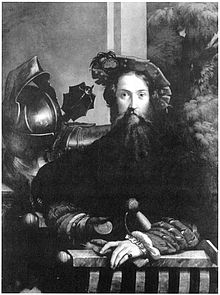Figure 4: Columbus
 Enlarge
Enlarge
In cases where no clear consensus existed as to the physical appearance of an “illustrious character,” Croome selected from among a number of widely circulating images. In depicting Columbus, for instance, Croome worked from a portrait by sixteenth-century Italian artist Francesco Parmigianino. In Parmigianino’s work the sitter appears as an intelligent, bearded, genteel man, serene even in his moments of despair, a delineation that comported well with Frost’s depiction of Columbus as a contemplative and self-sacrificing discoverer. [Image 23] It is revealing, however, that in adapting his portrait of Columbus from Parmigianino, Croome perpetuated an error of identity that had been made several hundred years earlier. [Image 24]
Anxious to find pictorial representations of the Italian explorer, especially dignified ones, eighteenth-century historians of portraiture convinced themselves that the Parmigianino likeness was that of Columbus, when in fact it was later shown convincingly to have been a likeness of sixteenth century Italian nobleman Gian Galeazzo San-Vitale.[35] Croome was not to blame for the perpetuation of this mistake, of course, because the Parmigianino Columbus was widely accepted as authentic in his day. Frost noted in the preface to his history that if Croome “erred” in terms of visual representation, he did so “with the countenance of learned and respected authorities.”[36] Such errors, however, were not uncommon in pictorial histories in which accuracy of attribution was less important than pictorial effect. Exaggerations of physical prowess and embellishments of spiritual character were frequent. A heroic figure such as Frost’s Columbus required a pictorial image suitable to his largesse, and Croome’s illustration fit the purpose.

